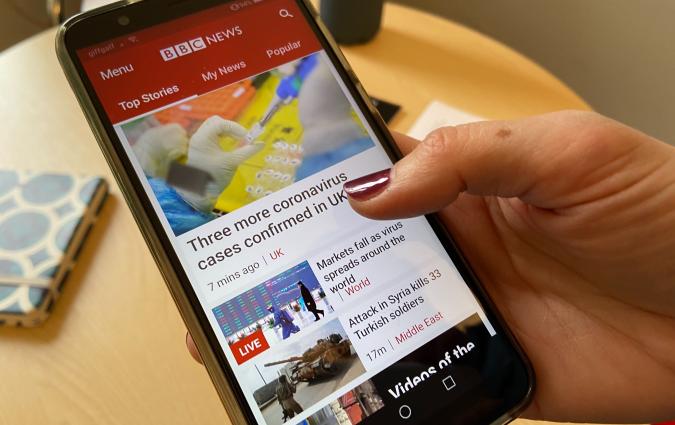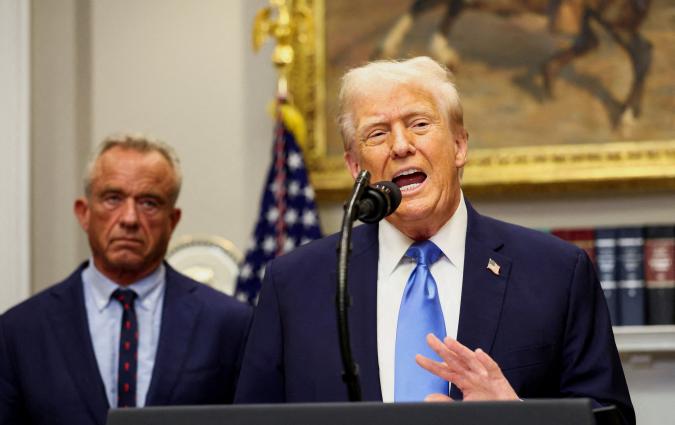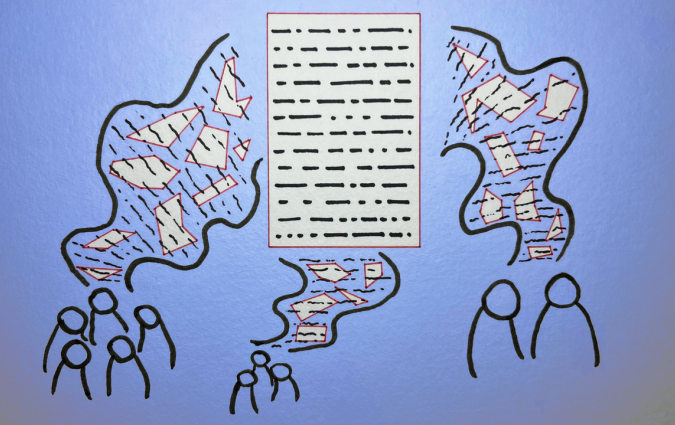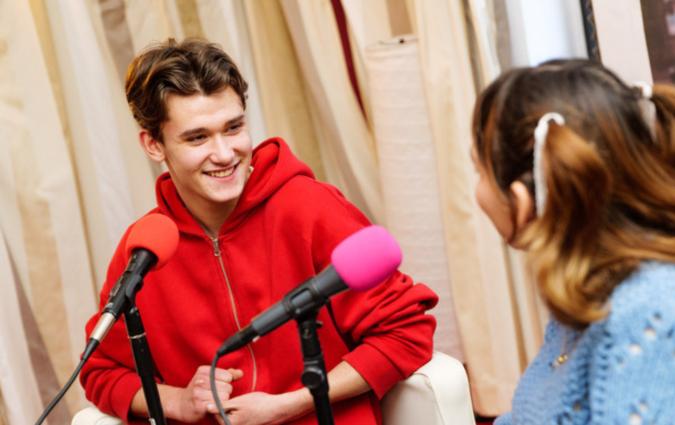Our podcast: Digital News Report 2025. Episode 4: How people check if information is real or fake
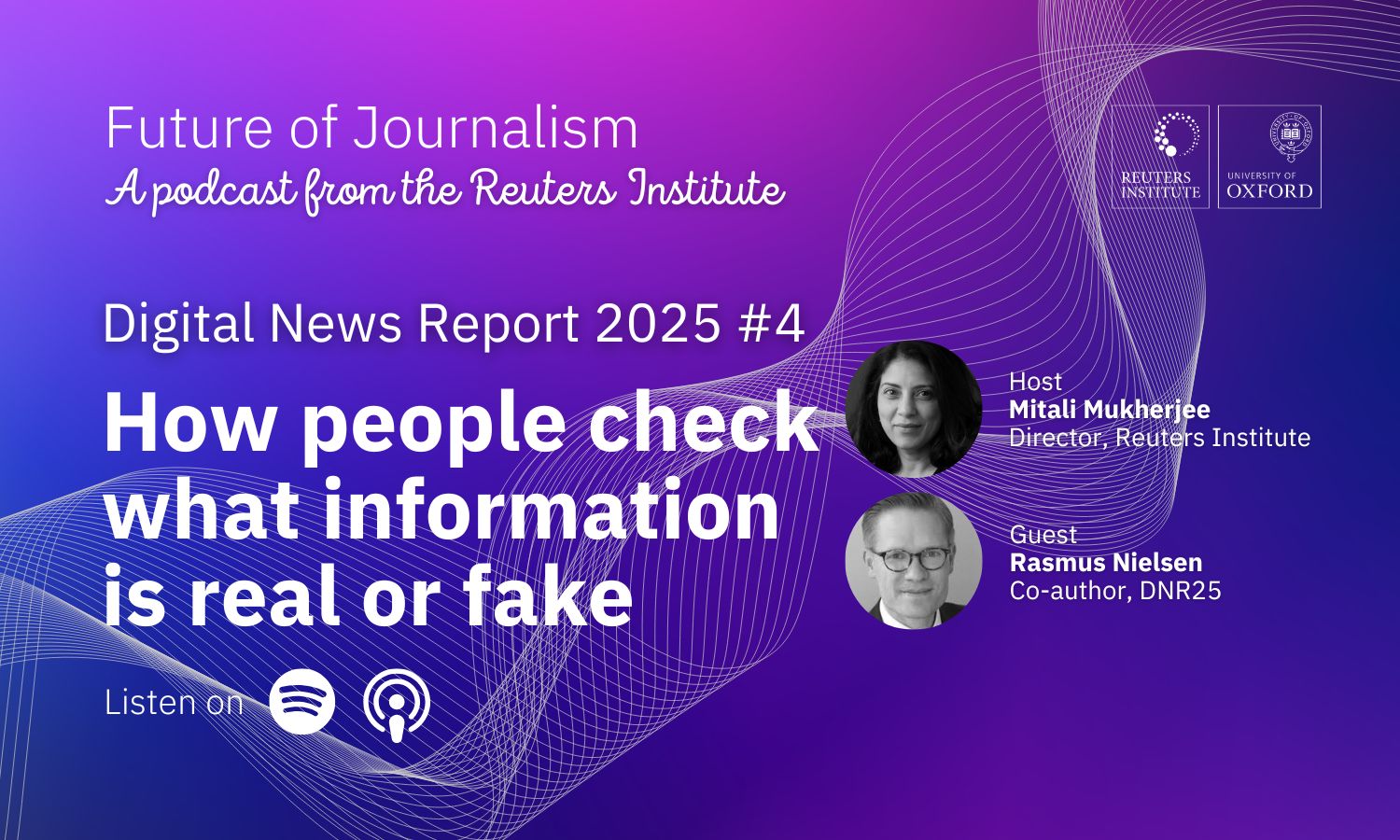
If people come across information which they suspect may be false, fake or misleading, where do they turn to verify or debunk it? This is the question at the heart of this episode of our podcast mini series on the Digital News Report 2025. We discuss what are the most frequently named sources, where news organisations fit in among the wider choice of institutions, platforms and fact-checking websites, and how this all varies according to different audience factors.
Speakers
Rasmus Kleis Nielsen is a Professor at the Department of Communication of the University of Copenhagen and a Senior Research Associate at the Reuters Institute for the Study of Journalism. He is a co-author of the Digital News Report 2025.
Host Mitali Mukherjee is the Director of the Reuters Institute and is a political economy journalist with more than two decades of experience in TV, print and digital journalism.
Transcript
Context and overview | Where news organisations fit in | The role of platforms | How different audiences verify information | How fact-checking organisations fit in | Trust in news and approaches to checking facts | What news brands people turn to | Takeaways for news organisations
Mitali: Let's do some context setting first. Rasmus, over the last few editions of the report, we have been tracking how the public feels and thinks about misinformation. You know, more broadly, would you explain the purpose of this chapter in the ‘25 report?
Rasmus: I mean the context, I think, is one in which it's clear that there are some very serious problems with various kinds of misinformation and unreliable information, not only online, but perhaps particularly noteworthy online, and it's very clear that much of the public is really concerned about this. So in the survey, when we ask people about how concerned they are, when they are thinking about online news about whether what they come across is real or fake. We have well over half of our respondents globally saying that they are concerned about this, even in countries with otherwise quite strong, robust media systems and strong fundamental rights, we have very widespread concern about this, and the concern is very, very high in more tumultuous policies such as the United States.
So what we want to do this year is to get a better empirical handle on given this widespread public unease when people encounter something, not just something they think might be wrong, but something important that they suspect may be false, misleading or fake. What do people do, or what they imagine they would do in such a situation? So that's what we set out to figure out with a set of questions this year where we try to understand better how the public checks information that it thinks might be wrong, and that way we can map both the source that people rely on, but also, of course, differences across the public and across countries in terms of how people respond when they're concerned about information integrity.
Mitali: Which brings us to the sort of natural outcome of what do they do? Is there a top two or three that we found in terms of what people say that they tend to do when they're checking information?
Rasmus: Well, I didn't want to leave you hanging like that, but so I will fess up and share the key findings here. I mean, I think the central finding really is that news sources that people themselves, personally say that they trust, are very important across the markets covered in the report, this is the most frequently named source that people say they would turn to in a situation where they're concerned. It's closely followed by official sources such as government websites and the like, and by search engines, which, of course, then, in turn, raises a question of, what sources will they then find via the search engine? But these really are the big three. 38% of our respondents say they would turn to a new source that they trust, and official sources and search engines are right behind them in terms of prevalence.
Where news organisations fit in
Mitali: 35% and then 33% for those two other categories. Just staying with news organisations, Rasmus, what does it say about how the public sees news organizations? And I suppose we're asking this question in the context of, you know, the larger cloud, if you will, around, what is the value of news organizations or trusted news organisations, as they tend to be seen.
Rasmus: I think those of us who care about journalism and news media and the role in society, will, you know, hold firm to the view that, with their imperfections, on balance, people are better off when they rely on news organizations as one of the sources of information that they that they turn to. But I think it's really important to to be very clear that this is not just a sort of a belief or an after dinner speech in the countries where we have research, which admittedly tend to be high income democracy, so it may not be representative of the wider and more varied experience across the world, but in those countries where we do have research, it's not just a sort of a belief that people are better off when they turn to news media. We know from research that relying on news help people be more informed, and in some cases, also more resilient to misinformation when when they come across it, and I think in that sense, it's good news, not just for journalists and news media and those who believe in the profession and the industry, but also from a sort of public point of view that so much of the public turns to news organizations, and the news organizations that people trust are the most frequently named source that people would turn to.
However, we also need to recognize that 38% say they do, but that, of course, leaves almost two thirds of the public who do not name news organizations that they trust as places they would turn to. Some of this may be due to a degree of disengagement and an uncertainty about where one would turn at all. We do have more than one in 10 respondents saying they don't really know where they would turn to so they're not really giving any options. Some of it might be about low trust in the news or just a preference for other sources that people, of course, can access online, whether that's official sources, specialist websites, fact checkers, Wikipedia or other sources that are not news organizations. So the good news from the point of view of journalism, news media is that they are the most frequently named source. The more complicated news is that two thirds of our respondents do not name news organizations as a place they would go to.
Mitali: Let's talk about the slice of the pie that says they turn to social platforms when they're looking to confirm information or they're looking for more context on something. What sort of sources do they rely on Rasmus when they look at those platforms? Because what we're talking about is something that is almost a receptacle for many other institutions to be present on that platform.
Rasmus: Yeah, of course, search engines and social media, at least so far, are not themselves providers of the information that people might get there if they turn to them, whether in general or in this case, to check something that they suspect might be false or fake or misleading. So we asked the follow up question for those respondents who name search engines and or social media as a place they would go to. And I think again here, the nuances are important to capture right. On the one hand, people do often say that traditional news outlets or journalists would be amongst the voices that they would look for in the results on a platform. But it's also important to recognize that they don't have the preeminence that they do amongst the respondents overall and official sources, so government websites and the like come out number one on social, they come out number one on search engines as well. And traditional news outlets and journalists are running neck to neck with a number of other sources on social, subject matter experts, alternative outlets, fact checkers, influencers and the like, only slightly ahead of influencers and Wikipedia. So it's a much more competitive environment, and it's one in which, in part, perhaps due to design decisions made by the platforms themselves, news does not have the preeminence that the professional industry might aspire to.
How different audiences verify information
Mitali: Let's, let's sort of address this in terms of what the demographic slice looks like. And I think that's the value and richness of the data we have in this report, which is that we are able to look at it with these different lenses. And it was quite fascinating Rasmus to see what it pointed to in terms of an age breakup versus what it pointed to when you sliced it for income or education standards, for instance. Unpack that for listeners.
Rasmus: Yeah, of course, the limitation of survey data in this context is that it's self reported, so we're asking people a question about what they say they would do in a given situation, and sometimes, of course, we in fact, act otherwise than we would like to think or would say when asked. But the great advantage, as you highlight, is that it gives us the opportunity to understand better differences across different parts of the public, by age, by education, by politics and the like. And some of the findings there, I think, are not only important, but also surprising.
So take age, for example. I think a very plausible hypothesis going into this research would be that younger people who tend to have much weaker direct connections with news brands, would be much less likely to say that they turn to news sources that they trust when they want to check information that they suspect might be false, misleading or fake. But that's not, in fact, what we find. The percentage of younger people, respondents under 35 who say they would turn to news sources is almost exactly the same as for older respondents. So actually, in this case, even younger people who may not be routine, habitual consumers of news from traditional sources, still in many cases, ascribe to news organizations a special place as a place you might turn to in a situation where you're uncertain about what to believe. So the difference here by age is not that news is weaker. It is not. The difference here is that younger respondents are more likely to say they would rely on comments from other users as a way to understand what might be really the fact of the matter. In a case like this, they are more likely to say they would rely on social media as a way to discover information to verify or counter what they've come across. They're more likely to say they would rely on AI chat bots.
So the way we interpret this in part, is about, we think, a greater comfort with and routine reliance on some of these digital platforms and new technologies. It might also suggest some supplementary ways of thinking about trust that are a little bit less institutionally centered, focused on news organizations, for example, while that is still important and creates a greater appreciation of more horizontal or affinity based trust relationships, where people think that other people like them might be a good source of information to check something that they're questioning the veracity of
Mitali: One area that you have done a lot of work in the past few years, Rasmus, versus around the political spectrum, but with special reference to those that don't identify with either left or right. What did we find for those, for that slice of the population that doesn't choose to align themselves politically? Where do they learn?
Rasmus: Yeah, I mean, I think there is a lot, and understandably and rightly so, of concern about the impact of polarization, political polarization in many societies, between differences between those who identify as being politically on the left and those who identify as being politically on the right. However, social sciences for a long time have insisted that we need to also consider this the other divide, the divide between those who are very engaged in politics, whatever their persuasions, and those who are less so.
So when we look at verification behavior by political orientation, we do see some differences between those on the left and those on the right. Those on the right are less likely to say they would turn to official government sources. They are less likely to say they would turn to fact checking websites. They are less likely to say they would turn to Wikipedia. Interestingly, they are not less likely to say they would turn to news sources that they trust, but largely there is actually quite a lot of commonality here between the politically engaged, even across different persuasions. However, when we turn to people who say they don't know where they stand politically, which we need to remember is a large part of our respondents, they are much more likely to say they don't know where they were turned to verify information.They are also much more likely to only name one source of verification, whereas many respondents name two or more. So this suggests that there is a sizable part of the public, which is about one in five are our respondents who don't have the same number of sources they would turn to and feel much more uncertain about what they would do in a situation where they are in doubt and and this is in a way, as a tied in with other issues of inequality.
We looked at age, as you brought up. But of course, we also looked at income and education, and some of these differences are also pronounced when we look at these sort of very classical indicators of social inequality, those with lower levels of education, and for that matter, lower levels of income are much less likely to say they would. Turn to news, they're much less likely to say they would turn to official sources. They're much less likely to say they would turn to search engines or fact checkers, even as they are equally likely to say they would turn to some of these more horizontal and affinity based forms of possible verification or checking someone they know and trust personally comments from other users and various kinds of social platforms. So there are some pronounced social inequalities in how people navigate this space.
How fact-checking organisations fit in
Mitali: Just a word on fact checking websites that you mentioned briefly, Rasmus, because that's another, you know, really sort of fascinating thread that emerges from the chapter that you've written. It's such a small subset in the wider news ecosystem, but it's interesting the kind of findings there were or self reported information there was about how much people lean on these fact checking sites when trying to double check information, particularly in a year where organizations like Meta have pivoted very hard against fact checking outlets, and it's more and more the theme and vibe seems to be community notes.
Rasmus: Yeah. I mean, there are some well known limitations to the ability of fact checkers to stem the tide of nonsense that floods the internet and many other information spaces. We know for a fact that the routine audience of fact checking websites is minuscule compared to that of news sites and let alone other major information providers. We know for a fact that it's very hard to match individual fact checks against individual citizens who have in fact encountered the false or misleading piece of information that the fact check pertains to. But we also know that even with these limitations, that independent, professional fact checking can play a really important role as one of the ways in which one enhances the integrity of the information environment.
For example, it has been shown very convincingly by social scientists that people tend to heed factual information even when it clashes with their political beliefs. In that sense, it really does matter that there are fact checks and whether people, in turn, at least sometimes rely on them. And I think what our survey suggests is that even if people may not often turn to fact checks and may not seek out fact checking websites, very often, there is a recognition of the importance of the work that they do, and at least a hypothetical belief that if there was a situation in which I as a citizen encounter something that was important to me and that might be false, misleading or fake, that this was one of the places one could turn to in that sense, I think fact checkers here really loom larger in the public imaginary around these things than their more limited institutional reality. And I do think it suggests that there are parts of the public who will be concerned if this industry and this profession is hollowed out by decisions to step away from engaging with them.
Trust in news and approaches to checking facts
Mitali: So we've talked about the segment that says they turn to news organizations and news sites to double check something we've talked about the segment that doesn't know where to turn. Does trust in news impact people's behavior when it comes to checking information?
Rasmus: It does. I mean, other research has shown that trust is one of the factors that influences both what news sources people rely on, but also how they process information that they come across. That doesn't mean that trust is the be all and end all, or needs to be a goal, let alone the only goal, of news organizations, but it does matter in how people orient themselves in information environment and how they process information two sort of clear ways in which we can demonstrate the role of of trust in the research.
One is the difference between respondents who generally have a fairly positive perception of the news overall. So those respondents who when asked the straight question whether they feel they can trust most news, most of the times, answer in the affirmative, and those who don't, those who are more skeptical and more doubting of the trustworthiness of news organizations, we see very real differences. So those who say they trust the news are much more likely to say they would turn to news sources that they trust to verify information. They're much more likely to say they would seek out results from traditional news sources in search. They're much more likely to say they would look for traditional news sources amongst the feed on a social platform if that was where they were trying to verify information. So it's clearly a factor that shapes how people navigate this and who they turn to, and it's also one that we see across countries.
So in countries where a greater proportion of the public say they trust the news in general, such as the Nordic countries, Finland, Denmark, Sweden, we have much larger parts of the public saying they would turn to news organizations to verify information, whereas in countries with lower levels of trust in the news: Italy, Spain, France, we have a much smaller share of the public saying they would turn to news organizations. So trust is a complicated matter, but it's very clear from the data that it's one of the factors that inform how people navigate this space, and it's also one of the contextual factors that shape entire national media systems.
What news brands people turn to
Mitali: It's also a very different news landscape for each geography and countries we've been mapping for many years now, and when it comes to people who say they do refer to trust news outlets when they’re checking information, is there a particular type of news brand that most of them seem to land on?
Rasmus: Yeah, I mean, trust is necessarily in the eye of the beholder, and not the same as trustworthiness. So we wanted to understand better that when people say they turn to news organization they trust, which outlets might they be thinking of, so we asked the follow up question and gave people the opportunity to name some brands which we then, in turn, coded.
And there are a couple of things I think that stand out from that. I mean, one is that in countries that have public service, media that are recognized as being genuinely independent and that are widely used and highly and broadly trusted. These are far and away the most frequently named news sources that people say they would turn to to check information. This is the case in the United Kingdom, where the BBC is far and away the most frequently named news source people say they would turn to if they wanted to check something. This is the case in Denmark, where I live myself, where DR is the most commonly named source that people turn to. So in countries that have genuine independent, genuine independent, widely used and highly and broadly trusted public service media, these seem to play a special role in terms of where people would turn.
Then there are other contexts that don't have such organizations and also are frequently much more politically polarized. And there, of course, we find a more complicated and different picture. So take the United States as an example. The two most frequently named news brands that people say they would turn to to verify information in the United States are CNN and Fox News. No prizes awarded for guessing which political persuasions are more likely to say they would turn to one or the other. So here again, it underlines that trust is in the eye of the beholder, and that there are organizations who have high reach, are accessible in the sense that they operate no pay wall or only limited pay systems. But in this case, there are organizations that are trusted by one side of the political spectrum and regarded with great skepticism by the other side of the political spectrum.
And many liberals will no doubt be disappointed to know that some people might turn to Fox News to verify information, but equally, many conservatives might be concerned that anyone would turn to CNN for a verification of information. So polarization runs through everything in the case of the United States and unlike the UK, there isn't a single point of reference that much of the political spectrum and many parts of the public would turn to as a way to verify information.
Takeaways for news organisations
Mitali: Absolutely and probably a super interesting year in terms of how peak politics got for that country and how it's reflected in these audience surveys. And I know a lot of our conversation has been about the fact that there is nuance in these findings, but is there sort of a core takeaway for you in terms of what news media should make in terms of the findings of this chapter?
Rasmus: I've always made it a rule of my work not to tell people what to do in their work, and I'll stick to that iron rule here. I think part of it is recognizing that organizations that strive to provide trustworthy information and operate with an aspiration towards due impartiality, at least in some societies, are achieving something akin to that position. In the eyes of much of the public. There are strong political divides. In the UK. There are even in a fairy tale context like Denmark, quite significant political disagreement laws. Quite heated political disagreement. And despite that, in again, in the global perspective, with these privileged contexts, there are organizations that have respect from across the political spectrum, and that many citizens say they would turn to as a source of information, many more people than say they would turn to even otherwise very respected news organizations that have a more strident editorial line, that may have other qualities, but may not be the place where people go to check factual information. So there seems to be an opportunity in that space.
But also, of course, importantly, in some situations, you can't please everybody, and sometimes you know you need to call it as you see it. And there will be moments in which organizations will have to choose between their commitment to truth telling and their ability to reach parts of the public. And that will complicate how news organizations help verify factual information when they come across it online, just as it complicates the aspiration of journalists and news media to reach the whole public in often quite disputatious societies.
In every email we send you'll find original reporting, evidence-based insights, online seminars and readings curated from 100s of sources - all in 5 minutes.
- Twice a week
- More than 20,000 people receive it
- Unsubscribe any time



